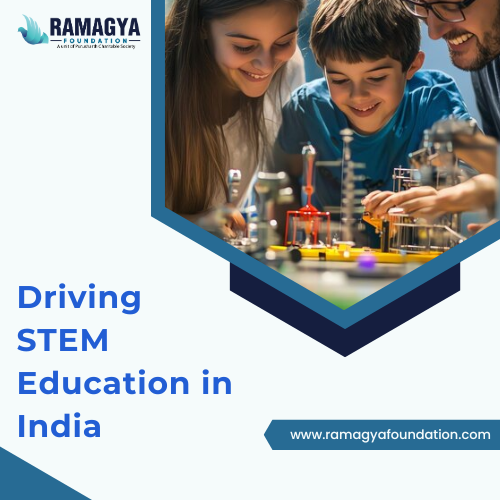The STEM education (Science Technologies, Engineering and Mathematics) is an important influence on the nation’s youth. It doesn’t only equip students with the essential technical abilities, but also helps develop the ability to think critically and digital literacy. It helps them prepare to meet the needs of the present world.
The education within STEM areas across India is concentrated on integrating engineering, science, technology and math into interdisciplinary learning. It focuses on learning through hands-on experience as well as problem-solving and creativity. It prepares students for careers in fields like cybersecurity and robotics, data science, and renewable energy.
This article will examine the significance of STEM education in India and the impact it has on critical thinking and digital literacy, and the strategies the driving force behind its growth.
Enhancing the Critical Thinking Skills
- Problem-Solving Abilities: STEM education in India enables students to address real-world challenges by using analytical thinking and logical reasoning. Students learn to apply their concepts they have learned to real-world situations, encouraging imagination and creativity.
- Analytical Thinking: Students acquire the ability to evaluate data, analyze data, and make informed choices. This ability to think critically is vital to succeed in both professional and academic contexts.
- Innovation and Creativity: Through participation with STEM activities and research, children are able to explore innovative ideas and strategies and develop a culture of creativity and innovation from an early age.
Digital Literacy in STEM Education
Digital literacy in STEM education refers to the ability to use through, analyze, and produce data using digital technology. It is the ability to work making use of computers, software programs, Internet resources, as well as knowing the ethics of digital security.
Integration of Digital Skills
- Technological Proficiency: The STEM curriculum teaches students with the technical knowledge needed to use and develop using technology and tools that are digital.
- Data Literacy: Students learn to analyze and interpret data, an essential ability in today’s world of data across many STEM disciplines.
3.Coding and Programming: An introduction to programming and coding helps students develop computational thinking and problem solving skills, preparing students for careers in the future of technology.
Challenges and Opportunities in STEM Education
Challenges
- Access to resources: Access to quality STEM-related resources and infrastructure continue to exist particularly in underserved and rural areas which limit educational opportunities.
- Shortage of Qualified Teachers: The difficulty in retaining and finding qualified STEM teachers who are able to effectively communicate complex concepts and encourage the ability to think critically among students.
- Gender disparity: Gender Disparity: Girls and women are not represented in STEM fields because of social norms, a lack of role models and biases, which impact innovation and diversity within these areas.
- Curriculum rigidity: Educational systems usually place a high value on rote learning over practical applications and interdisciplinary learning, which hinders learning and problem-solving abilities in real-world situations development.
- Equality and inclusion: Ensuring equitable opportunities for equal access to STEM education for those from marginalized communities as well as those with low socioeconomic backgrounds and with handicaps, is a major challenge.
Opportunities
- Innovative and Creative: By pushing students to reflect on their ideas and hone their creative thinking abilities to solve problems in the real world, STEM education fosters an innovative attitude.
- International Collaboration: Researchers, teachers, and industry experts can work together both domestically and abroad to improve knowledge exchange and resource accessibility.
- Skills for Careers: The training of students for the highly competitive career paths in engineering technology, health and environmental sciences, as well as healthcare sciences by developing practical abilities and experiences relevant to the field.
- Entrepreneurship: Providing students with the opportunity to be entrepreneurs in the near future by encouraging entrepreneurial thinking and providing opportunities to startups, ventures, and fresh concepts.
- Diversity and inclusion: Inspiring diversity within the STEM field through engaging underrepresented groups by creating inclusive learning environments and recognizing diverse perspectives.
Initiatives Driving STEM Education Growth in India
- Government Support: The Indian government has rolled out initiatives such as that of the Atal Innovation Mission and the National Mission on Education through ICT (NMEICT) to help promote STEM education in universities and schools.
- Industry and Academia Collaboration: Collaborations between educational institutions and business leaders allow students to experience the real-world application to STEM concepts, while also enhancing the practical skills needed for career development and job readiness.
- Skill Development Programs: Different skill development programs and contests like hackathons, robotics leagues and science fairs, encourage students to investigate STEM-related fields and show off their skills.
- Teacher Education Programs: Educational programs that train educators will make sure they have the skills and knowledge required to effectively instruct students in STEM subjects and encourage students to explore career paths in STEM.
Impact of STEM Education beyond Academics
Education in STEM fields of India extends beyond learning in the classroom and influences the various aspects of a child’s everyday life.
Broader Impact:
- Career Opportunities: STEM graduates are highly sought-after around the world, contributing to India’s rapid growth in areas like manufacturing, healthcare, IT and research.
- National Development: Innovation fueled by STEM education is a key factor in technological innovation, economic growth in addition to sustainable progress.
- Global Competitivity: Creating an efficient STEM workforce improves India’s ability to compete in the global market by attracting investment and encouraging entrepreneurial spirit.
Conclusion
In the end, STEM education is essential to prepare India’s young people to adapt to a constantly changing world. Through focusing on critical thinking skills along with digital literacy, the pursuit of innovation, STEM education equips students with the skills they require to be successful in the twenty-first century.
As India continues to invest in STEM initiatives and promote collaboration between industry, academia as well as the government, it opens the way to a brighter future powered by technology, innovation, and a skilled workforce.
